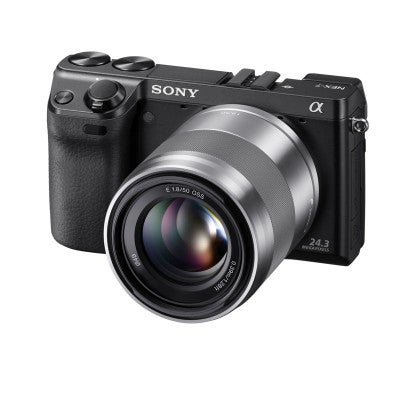We got our hands on a pre-production Sony NEX-7, and talked exclusively to Sony UK's Paul Genge about the new Compact System Camera
Sony NEX-7 First Impressions
The Sony NEX-7 is a Compact System Camera unlike any other yet produced. Up to now there has broadly been two types of CSC: DSLR style and compact camera style, the key difference between them apart from shape, being the inclusion of a built-in electronic viewfinder (EVF) in the former. The NEX-7 is a hybrid of the two styles. It takes the compact styling of the rest of the NEX range as a starting point, but blows it up in size and adds an EVF. In outward appearance its styling and sober black-only finish is reminiscent of M series Leicas and immediately conveys that this is a serious camera aimed at a different and more advanced audience that CSCs have targeted thus far.
Its specification is top of the range: the same brand new 24.3MP APS-C CMOS sensor as used in the new Alpha 77 and 65 DSLRs, and also the same 2.3 million dot OLED viewfinder. Both are world leading and, at the moment, unmatched by any other manufacturer. (Samsung’s new NX200 comes closest to the NEX-7’s sensor resolution with 20.3MP)
But it’s in the design and handling that Sony has invested the most energy. Previous NEX cameras are designed primarily for point-and-shot use, not for those who like to have quick access to the key settings such as the ISO, White Balance and Dynamic Range, and altering such parameters on these cameras can be a frustrating process. With the NEX-7 Sony has gone to the opposite extreme by introducing the most flexible control system yet seen on a CSC. Sony calls it the Tri-Navi system because it comprises three controls – the rotary dial on the back plus two new unmarked dials on the top which can be set to pretty much whatever you want them to be. A button on the front of the camera allows you to toggle through all the various functions that can be applied to these dials, so you can change them at any time without recourse to the menu – and, thanks to the EVF, without taking your eye off the subject.
In practice the system works well. The dials are well placed and the various options offered by each of the dials is displayed along the top of the LCD screen as you scroll, in case you forget what you’ve set them to do. Tri-Navi is a neat solution to the problem of providing direct access to the settings without covering such a small body in a plethora of buttons.
Also new on a NEX camera is a built in flash which pops up out of the body on a cantilever contraption, and if that isn’t sufficient there’s also a hotshoe so you can attach Sony’s range of Alpha dedicated flashguns.
Alpha Mount Adaptor
One of the appeals of the NEX system is that its shallow body enables the attachment of adaptors for pretty much any lens mount. Sony’s new LA-EA2 Alpha mount adaptor features its own translucent mirror and AF module so that any Alpha lenses attached to it behave like they do on Alpha cameras, with the superior phase detection AF. But with the right mount you can fit all kinds of lenses, both current and obsolete, and it is envisaged that the NEX-7 will be popular with owners of Leica M series lenses in particular.
The NEX-7 we handled is an early pre-production model and we were not allowed to put an SD card in it to assess to image quality, as there’s still some tweaking to be done to the firmware, but from a handling and usability perspective the NEX-7 is impressive. Its discreet form makes it an ideal street photographer’s camera. The tilting 921k dot LCD screen facilitates candid shooting but the inclusion of that superb EVF, which we have already seen on the Alpha 77, makes it a great option for those who would never consider buying a camera without a viewfinder.
It isn’t cheap. At around £1100 or so for the body it is much the same price as the Alpha 77 which outperforms it in many areas, but it’s a different proposition aimed at different type of user. It isn’t a cheaper alternative but an equal one, in different ways. It will appeal to those who want to travel light and we see it being used more with premium prime lenses, such as the pancakes, than with zooms. The prospect of that 24MP sensor paired with Leica M series lenses is particularly salivating, especially given the price of the body compared with the £5000 Leica M9.
The NEX-7 will be in UK shops by the end of November, and we hope to have a full review as soon as it becomes available.
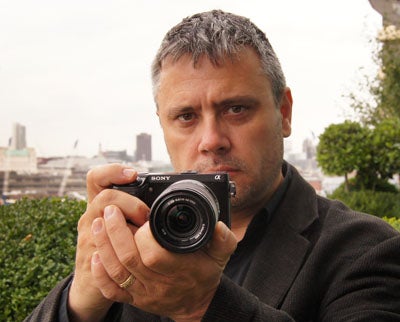
The NEX-7 will only be available in black.

The NEX-7 is the first NEX with a built in flash
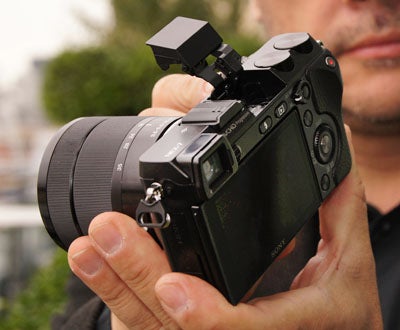
Back view of the NEX-7
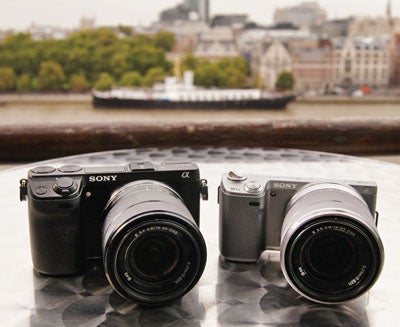
Compared with the NEX-5N (right)
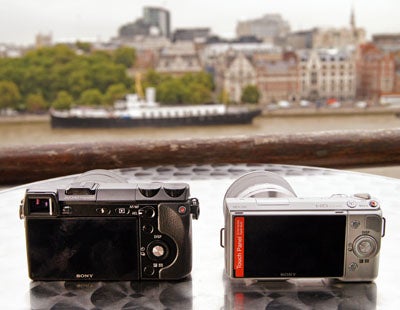
Compared with the NEX-5N (right)
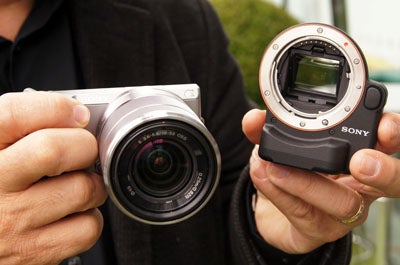
With the LA-EA2 adaptor, for Alpha lenses
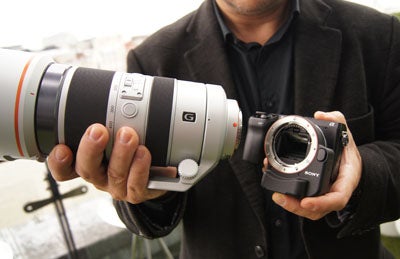
The LA-EA2 adator provides Phase shift AF with all Alpha AF lenses





